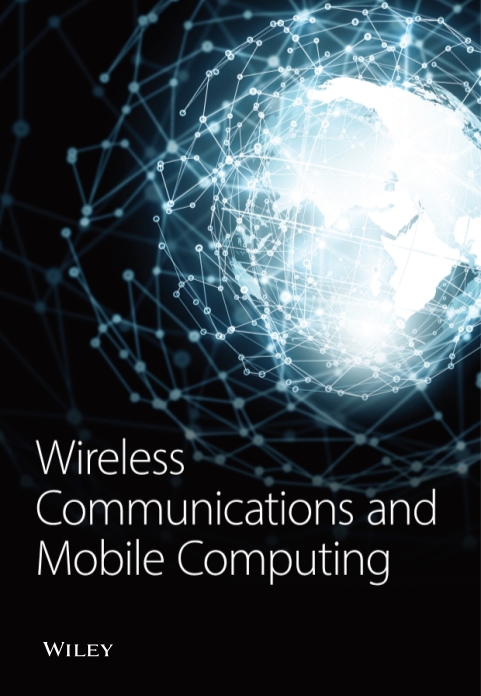The Impact of Artificial Intelligence Technology on Market Public Administration in a Complex Market Environment
Abstract
Artificial intelligence (AI) technology is applied to various fields and industries with the rapid development of Internet technology. This study aims to promote the intelligent popularization of market public management strategies based on data analysis through the development and promotion of AI. AI technology is used to optimize the integration of the Market Public Administration organizational structure system, and machine algorithms process the data set. A public utility platform management system is established, and a complete public utility management assessment system and platform are based after classifying the data. Research has found that AI technology has been used in the Market Public Administration field to effectively improve work efficiency and solve the duplication and complexity of work in the management process. This has also opened a new chapter for the use of AI technology innovation. The results show that AI technology uses two driving logics of data and algorithms to intelligently solve the management problems and form a complete operating system to reflect the role of AI in the management system.
1. Introduction
Information technology and artificial intelligence (AI) technology are merging with industry. This means that society has entered a higher class of the information society—the era of intelligence. Meanwhile, this is also the core competitiveness of mankind’s fourth industrial revolution. More and more intelligent applications are deeply integrated into all aspects of social operation with the development and maturity of AI technology [1].
AI has brought about many social problems such as algorithmic discrimination, employment substitution, privacy leakage, and lack of responsibility. The data transmission and resource scheduling of the dense wireless communication network with total frequency reuse used by the AI algorithm is also a difficult task. Meanwhile, it also brings significant challenges to social governance with the government as the leading role [2]. Both the public service space dimension and the parallel dimension will be affected and changed. The widespread use of AI technology has accelerated the advent of the digital age and the degree of intelligence in society. The whole organization is developing in a highly unified direction [3]. Individuals must adapt quickly to technological approaches and the environment as the times evolve and public governance approaches change rapidly. When thinking about the impact of AI technology on the management model of public utilities, people must use external forces to break through the current traditional and inertial thinking [4] to build the entire management framework. Due to the unique advantages of Artificial Neural Network’s data computing capabilities, it is widely used by scholars in market data management and complex environmental analysis.
This study explores the possibility of AI technology replacing humans in public utility management. The purpose is to use relevant data algorithms to isolate the management system from the tradition [5], establish a new management model and management system, and discuss the impact of AI on utility management. The innovation lies in the effective use of AI technology [6]. This comprehensively expounds on applying AI technology systems in public utility management based on a data-driven, integrated intelligent logic system. New dimensions and methods are used to learn AI. The logic follows the structure that assumes the problem’s existence—solves the problem—concludes, and ensures that the prevailing thinking is coherent. This line of thinking can give readers a better understanding of the impact of AI on public utility management and the changes it has made in its direction.
2. The Knowledge Base of AI and Public Market Management
2.1. Origin and Development of AI Technology
After the definition of AI was proposed at the Dartmouth Conference in 1956, it has not been redefined during its decades of development [7]. However, a clear development trend has been formed based on the beginning of AI production:
AI is a machine agent that simulates human thinking and behavior and demonstrates human-like capabilities under the support of technology [8]. It had gone through three stages from when AI was proposed and developed to now being used in the realm of life [9]. It is divided into a weak AI phase (including simple calculation and storage), a decisive AI phase (perceives surrounding things), and a super AI phase (makes plans to respond to changes in the surrounding environment) [10]. The development process of computer technology has mainly gone through three stages: weak AI, AI infrastructure, and super AI. The three stages of computer technology are shown in Figure 1.

In Figure 1, the development of computer technology has gone from the most straightforward data storage to the final human interaction. This process realized human-computer interaction, and a qualitative leap and change occurred. More and more fields use computer technology to reduce labor expenses and improve work efficiency.
2.2. AI Technical Features and Key Algorithms
It has the following characteristics:
The essence of AI technology is computing technology based on data and a series of algorithms [11]. At this stage, AI is still based on machine form. Programming code is used for basic operations, and data mining is used for processing and predicting results. AI responds to instructions. This type of work procedure can liberate people from complex work and reduce marginal benefits. It has self-learning performance and human self-adaptive characteristics, responds to changes in the environment and data, and adapts to the changing environment [12]. AI is based on the calculation rules shown in Figure 2.
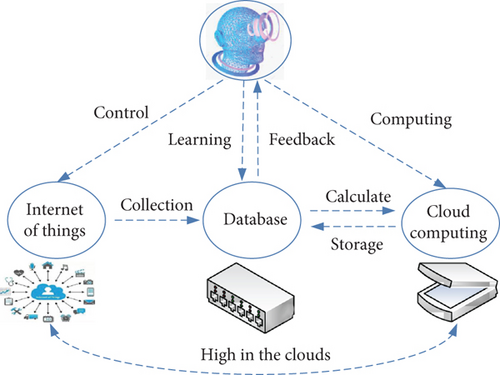
In Figure 2, after AI obtains information and data through the Internet of Things, data mining and other technologies are used for processing and application in the database. Finally, the operation of the interface is realized and displayed.
The application of AI in public utilities is also the application of these critical technologies [13], as shown in Table 1.
 |
 |
 |
 |
 |
 |
| Smart government robot | Smart phones | Question-and-answer systems, intelligent search, and intelligent translation | Face recognition systems, iris recognition systems, and biometric systems | Voice assistants | Intelligent services |
| Intelligent robot | Smart terminal | Natural language processing | Computer vision | Biometrics | Interactive |
AI technology has been applied to all areas of life, from food, clothing, housing, and transportation to every detail of life has the shadow of AI. Daily life has been changed by AI technology. In addition, standard AI computing key technologies mainly fall into seven categories: machine learning, knowledge graph, natural language processing, human-computer interaction, computer vision, biometric recognition, and virtual reality/augmented reality [14].
2.3. Philosophy and Structure of Market Public Administration
At present, the transformation of public utility management models in various countries also follows the overall process of governance tool reform [15], governance mechanism innovation, governance structure optimization, and ultimately the fundamental transformation of market governance concepts from the root value level [16]. Important government governance paradigms under national governance systems such as digital governance, data governance, innovative governance, and innovative governance have emerged with the advancement and application of technology [17]. The market structure presented by Market Public Administration after historical washing is shown in Figure 3:
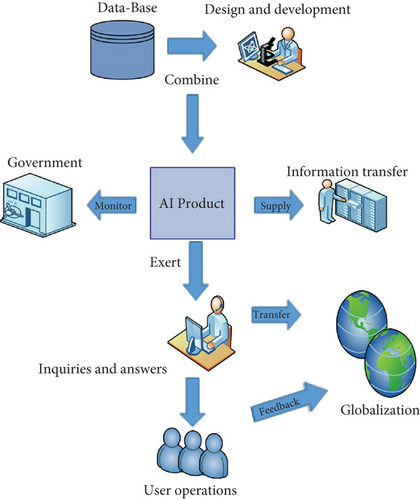
In Figure 3, AI technology is regulated by the Chinese government, which in part reflects the potential of the market and a relatively high degree of control over information. Designers and developers conduct data analysis according to the system database and develop and design AI products to provide users with information services. User groups and corresponding technical testing methods interact with each other. The flow of information is not one-way transmission, and the problems faced by the entire public market management field are relatively severe in the global market [18].
3. Artificial Neural Network Technology in Public Market Management
In recent years, with the advancement of science and technology in China, some people have pointed out that “strengthen the integration of AI and social governance, develop an AI system suitable for government services and decision-making, strengthen the integration of government information resources and accurate prediction of public demand, promote the construction of smart cities, promote the in-depth application of AI in the field of public safety, and strengthen the application of AI in the ecological field, improve public service and social governance [19].”
3.1. Logic Algorithm of Artificial Neural Network Technology in Market Public Management
The internal logic of Artificial Neural Network (ANN) applied to market public management lies in the field of public market. The application scenarios of AI technology are generally divided into three types: (1) use computer visualization and language functions to replace general managers in the design of related programs to perform preliminary personnel screening, introductory business consultation, and other related procedural work [20]. (2) Data mining technology is currently used in medicine, science, and education. It is based on a complex and multidimensional database to discover the laws and inherent patterns that people cannot find with the naked eye to help improve the quality of public decision-making. The most used are neural network algorithms [21]. (3) Intelligent design systems are used for development and application. The corresponding results are predicted through a series of data simulations to help public managers choose the best plan to avoid losses and dangers in time [22]. The internal logic of AI in public utility management is shown in Figure 4.
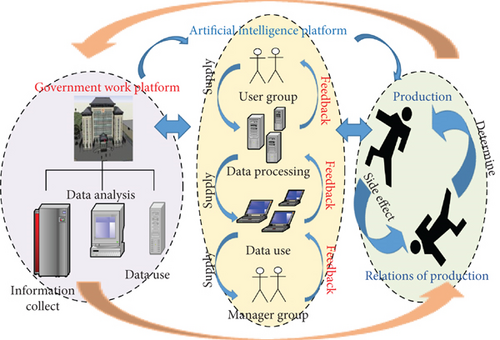
In Figure 4, the internal logic of Market Public Administration is determined by government, market, and computer technology development. These elements are interlinked, restrict each other, and promote each other’s growth. Each part also has its independent operating system.
3.1.1. The Objective Basis of AI Technology in Market Public Administration
From the application and practical operation of AI technology in public management, its application requires several processes: intelligent infrastructure construction ⟶ intelligent algorithm design ⟶ brilliant application landing [23]. Correspondingly, three functional levels are formed, infrastructure layer ⟶ algorithm layer ⟶ application layer [24], as shown in Figure 5:

In Figure 5, firstly, the manager contacts the application layer. The system application layer includes hardware devices and software. This layer is directly responsible for docking with the application program interface and providing corresponding network services. However, the infrastructure layer and the algorithm layer are the most vulnerable from an encounter risk perspective. Because of its relatively low location, it is more vulnerable to attacks and viruses. If something goes wrong at the bottom, the entire network system suffers losses and risks. Therefore, AI is most likely to destroy the underlying infrastructure and corresponding algorithms and then conduct it step by step. Risk analysis needs to be combined with risk to analyze along the conduction path. In public utility management, public service behaviors are digitized and displayed to form complete electronic data. According to data collection for leadership, the data is converted into binary data form and then used. In the past two years, due to the impact of Corona Virus Disease 2019 (COVID-19), the use of AI in public service management has been rapidly developed and well-governed. This speeds up the data processing process from the decision-making end to the server end.
3.1.2. AI Technology in Public Utility Management
Public service is the core issue in government governance, and ensuring its rationality and fairness is now an urgent issue to be solved. AI technology has no vibrant color and is based on statistical data analysis. This will significantly help promote the further improvement of public management services. AI technology has its unique algorithm system to replace human thinking habits and laws and show specific “human-like” characteristics. But computer technology still cannot replace all human behavior. It cannot replace human beings in autonomy and application ability. The specific algorithm is as follows:
D represents the evaluation system of public management services, including three levels of A, B, and C. A is the highest, C is the lowest, and n is the evaluation index for public utility management.
The output is as follows: information gain rate, department weight, key value of index validity, and department total weight.
Dj represents the probability that a random event j is Dj. Information entropy refers to the possible value that measures a specific occurrence at a time.
The branch with the largest gain rate is selected as the splitting attribute. The calculation and data processing system digitizes all the information and implants it into the AI system for the next calculation step. The system forms a complete closed-loop at the primary level. Since the 1990s, computer technology has received significant attention and is used in public management. Countries are emphasizing the importance of computer technology being used in the general direction. They hope to improve the efficiency of national administration. Therefore, this is consistent with the “3E” concept of efficiency, effectiveness, and benefit emphasized by the New Public Management Movement [25]. Meanwhile, in the management of public utilities, the development of AI technology relies on the realization of data mining and other technologies to establish a complete system.
3.2. AI Operating Mechanism
3.2.1. AI Technology Interacts with the Logical Structure of Public Management
Firstly, in public management, AI technology has undergone overall logical structural changes in driving management models. Within the management model, the development and application of new technologies led by AI establish a digital, intelligent, and intelligent platform and an excellent environment for management convenience. This can further promote societal changes, drive the world to a more innovative society, prompt a comprehensive revision of public management methods, and affect internal operations and management systems. The organizational structure for discussing technology and task environment has been wholly based on Frederick Winslow Taylor’s point of view. The focus should be on how the organizational structure affects the overall complexity and uncertainty of the technology used [26]. In the public utility management logic, AI-driven changes include six processes, target identification, AI application, equipment association, system architecture, structure optimization, and government resource allocation, as shown in Figure 6:
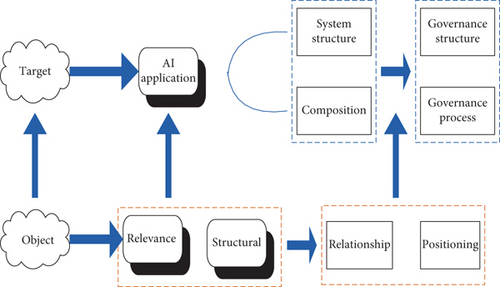
In Figure 6, the transformation of AI technology’s public utility management model is to analyze and calculate data variables to optimize the internal governance system and promote governance changes. In addition, AI technology also has a particular impact on the organizational structure of public utility management, as shown in Figure 7:

In Figure 7, in terms of the structural dimension of public utilities, AI uses performance to change the overall structural size through data assessment and analysis of the organizational structure. Furthermore, based on the AI operating mechanism, the structural dimensions of public utilities are evaluated, as shown in Table 2. Among them, N1, N2, N3, N4, N5, and N6, respectively, represent the influencing factors such as the supply and demand of graduates in public utility management, talent training methods, public employment psychology, career planning, public employment environment, and education system reform. K represents the public utility structure evaluation coefficient of these influencing factors under the AI operating mechanism.
| N1 | N2 | N3 | N4 | N5 | N6 | |
|---|---|---|---|---|---|---|
| K | -0.54 | 0.43 | 0.15 | 0.42 | -0.37 | 0.35 |
3.2.2. The Micromechanism of AI Technology to Promote the Reform of Public Management Mode
AI is analyzed in terms of the basic premise, technical algorithm, value criterion, goal orientation, and logical structure of the management model change. This will help AI reform to evaluate and use public management more rationally. After the research is refined, AI technology affects the public utility management model through penetration-conduction-diffusion. The quantified data of different cost management methods are shown in Table 3. The micromechanism model of management reform is shown in Figure 8.
| Cost management | Project price cost factor | Project time cost factor | Responsibility and task cost factor |
|---|---|---|---|
| Target cost management | 0.26 | 0.63 | 0.19 |
| Activity cost management | 0.38 | 0.81 | 0.49 |
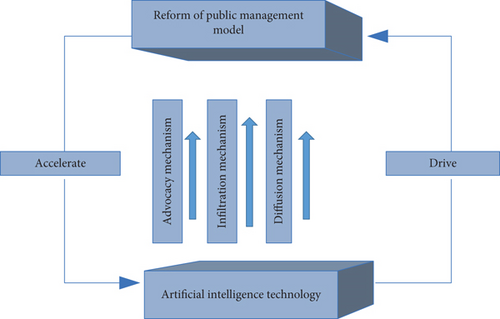
In Figure 8, while AI technology is driving the transformation of public utility management mechanisms, the backward tool of public utilities also accelerates the further development of artificial technology. The angle of AI development and the theoretical technology used are different in different fields and systems. Currently, AI technology is popularized due to the development of the Internet. However, AI’s applicable principles and values have not been further updated and understood. Therefore, firstly, AI technology must be promoted to a rational understanding of public management. Secondly, a complete governance framework and system have been prepared regarding technology. This can help humans solve problems. The method of public utility management should also be further changed to promote a sound system of public utility management models. Finally, the practical application of AI technology in public utility management has been improved throughout human society. With the development of the times and technology, continuous innovation has been made to meet the needs of current humans.
3.2.3. AI Technology Promotes a New Dimension of Public Utility Management Reform
The foundation of the public administration business model is analyzed from three dimensions: concept, structure, and method. In the field of AI, the development and soundness of public utilities are closely related to the three elements of AI. Among them, AI technology is mainly divided into application limitations and development guidelines. These two aspects are jointly supervised by the government and the public and finally realize the value standard of AI technology, as shown in Figure 9:
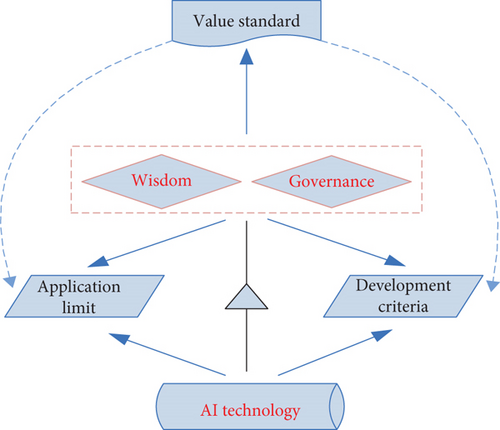
In Figure 9, the interaction of technology, structure, and content can reduce the duplication of labor expenditures and further clarify the new direction of public utility management. Combine diversified dimensions to analyze and maintain data and use the advantages of technology to develop human expertise. It is impossible not to adopt technical means or rely entirely on technology.
3.3. Application of AI in Market Public Administration
These implementation methods and means are used to establish public utility management responsibility departments suitable for China’s national conditions and carry out statistical implementation based on existing research results. In this way, responsibilities can be traced back, guilt can be divided, and a unified distribution plan can be carried out, as shown in Figure 10. Among them, the public’s application of AI technology is mainly divided into four aspects: government supervision, protection, operation, and supervision. These four aspects together form the core of AI technology.
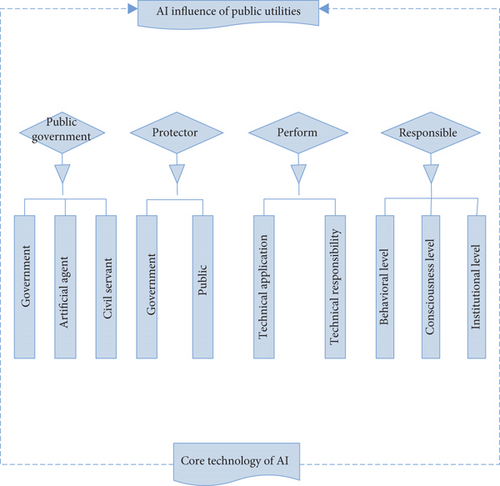
In Figure 10, each department has a clear division of responsibilities. On the one hand, it reduces the excessive intervention of AI technology, and on the other hand, it also optimizes work efficiency. AI technology has brought both opportunities and certain risks in the management of public utilities through a comprehensive analysis of AI, matching, and a detailed understanding of the characteristics of the public management system.
4. Results
The further development of AI technology has prompted the public to realize that human beings are entering an intelligent social environment, but how to deal with the peaceful development between the two needs to be resolved urgently. From a technical perspective, human beings are at a stage where weak AI dominates AI and AI cannot survive without human beings. Therefore, AI technology reduces labor and encourages more people to enjoy this fair benefit. In addition, the government is the core theme of public governance. It should actively establish its attitude towards AI technology, vigorously promote the application of AI technology in various fields, promote the reform and innovation of the management model of the times, and solve the current inequality and inequities. The number of patent applications in the field of AI technology in China in recent years is shown in Table 4. The number of AI applications in various fields is shown in Figure 11:
| Year | Computer identification | Instruction recognition |
|---|---|---|
| 2010 | 500 | 400 |
| 2011 | 600 | 500 |
| 2012 | 700 | 600 |
| 2013 | 1000 | 900 |
| 2014 | 1800 | 1400 |
| 2015 | 2200 | 2000 |
| 2016 | 5000 | 3600 |
| 2017 | 8300 | 4000 |
| 2018 | 3900 | 900 |
| 2019 | 8500 | 4300 |
| 2020 | 10000 | 5000 |
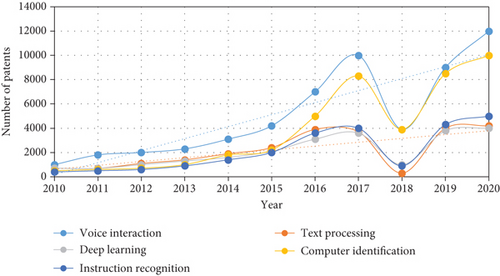
Figure 11 shows that AI technology has developed rapidly in recent years, and many patents have been applied in the AI field. Many of these technologies have been used to public utility management and have been growing steadily from 2010 to 2017. In 2018, the number of patent applications in AI technology was not as high as in the past, but after 2018, there has been significant progress. This also represents the accumulation of AI technology in the field of intelligence. Meanwhile, the application of AI technology in public utility management has become more mature and robust. Figure 12 shows the percentage of patents applied for in the application of AI technology in the field of public utility management in China from 2019 to 2020:
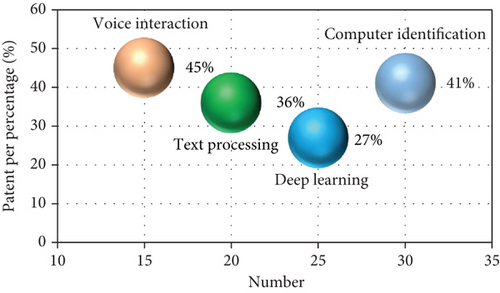
In Figure 12, 45% of the patent applications for voice recognition technology have been applied in public utility management. In addition, computer recognition reached 41%. This shows that as the development of Internet technology tends to mature, various functions in the AI field have been improved and upgraded in the management of public utilities. AI embodies extraordinary achievements in four aspects: voice interaction, text processing, deep learning, and computer learning. The development and maturity of AI technology are changing the management system of public utilities, and humanity must make equal changes and progress while adapting to changes. The percentage change data of AI technology in the public domain is shown in Table 5:
| Year | Voice interaction | Text processing | Deep learning | Computer identification | Instruction recognition |
|---|---|---|---|---|---|
| 2010 | 1000 | 700 | 700 | 500 | 400 |
| 2011 | 1800 | 700 | 700 | 600 | 500 |
| 2012 | 2000 | 1100 | 1000 | 700 | 600 |
| 2013 | 2300 | 1400 | 1300 | 1000 | 900 |
| 2014 | 3100 | 1900 | 1600 | 1800 | 1400 |
| 2015 | 4200 | 2400 | 2100 | 2200 | 2000 |
| 2016 | 7000 | 3900 | 3100 | 5000 | 3600 |
| 2017 | 10000 | 3700 | 3600 | 8300 | 4000 |
| 2018 | 3900 | 300 | 1000 | 3900 | 900 |
| 2019 | 9000 | 4000 | 3800 | 8500 | 4300 |
| 2020 | 12000 | 4200 | 4000 | 10000 | 5000 |
5. Conclusion
With the explosive arrival of the era of big data, AI technology is widely used in life. This greatly enriches the human world and liberates people’s minds. Studying the application of Internet technology and discussing its advantages and disadvantages in public utility management will help people to have a clearer understanding of Internet technology. Internet technology uses data processing and collection to realize simulation exercises and further simulates and predicts the following realization paths and results through data statistics. In public utility management, the principle of fairness and justice is the most difficult problem to solve. AI technology is based on the simulation of Internet neural network algorithms. The management logic structure of the public sector is further planned, responsibilities are divided, and management digitization is realized through data calculation and operation. This study explores the origin and development process of key AI technologies, focusing on AI neural network technology, and discusses the structural model of public market management. Based on the AI operation mechanism, the research focuses on the reform and innovation of public utility management from three dimensions. The project time cost coefficient of target cost management is 0.63, and the project time cost coefficient of activity cost management is 0.81. The time cost of activity-based costing is higher than that of target costing. The results of the study show that 45% of speech recognition technology patent applications have been applied to public utility management. In addition, computer recognition reached 41%. This shows that the development of Internet technology tends to mature. The research provides new directions for the development of public utilities on a specific basis, with implications for many utilities and other organizations. Additionally, due to regional differences and the accuracy of related algorithms, there are still some shortcomings that need to be discussed. In the follow-up research process, the overall fluency of algorithmic processes and experiments will be enhanced through sophisticated drills and data processing.
Conflicts of Interest
The authors declare that they have no conflicts of interest.
Acknowledgments
This work was supported by the Key Research Base of Humanities and Social Sciences in Guangxi Colleges and Universities, the 2020 Annual Project of Humanistic Spirit and Social Development Research Base in Dian-Qian-Gui edge Old Revolutionary Area: “Research on the Development Path of Featured Products ‘Internet+’ New Retail in Old Revolutionary Area,” Project Approval Number JDB12.
Open Research
Data Availability
The datasets used and/or analyzed during the current study are available from the corresponding author upon request.



